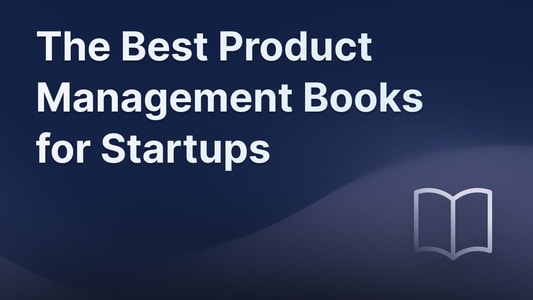Blog Product ManagementHow To Optimize The Product Management Process (Step-by-step)
How To Optimize The Product Management Process (Step-by-step)
Want to build a product management process that takes your startup to the next level? In this post, we'll share our own experiences and practical tips on how we've achieved this. Let's get started!

Do you want a more successful startup? Effective product management might be the answer. Studies show that managing your products well can increase profits by 34.2%.
But it's not as simple as it sounds.
Product management includes market research, product development, pricing, and marketing. Each of these areas requires a different set of skills and knowledge.
So, how do you build a product management process that works?
In this post, we’ll walk you through the steps of creating an effective product management process—from understanding your target market to using data to make informed decisions.
Let's get into it!
What is a product management process?
Product management process is the practical application of product management theories.
It’s how you take a theory (like collecting and prioritizing user feedback) and make it work in the real world by defining:
- When will you do things
- Who is responsible for what
- What tools do you need to get the job done
- How do you measure success
The idea is to create a structured and repeatable approach to managing products. This is what a good product management process will give you.
Most product management processes online are very repetitive. Our goal is to offer actually practical tips from our own experience to help you get more out of your product management process.
How to optimize the product management process
1. Use prioritization frameworks
Prioritization frameworks are one of the best tools for enhancing your product management process.
PMs are constantly asked to compare different projects. If you can standardize this process with a framework, you unlock benefits like:
- Improved decision-making
- Better communication with stakeholders
- Reduced bias and subjectivity
- Clearer understanding of trade-offs between projects
One of the most common areas this comes into play is feature prioritization. With a framework in place, it’s easier to determine which features are “most important” based on your users and business goals (or whatever criteria you choose).
Here are a few models to get you started:
a) Value vs. Effort
This framework evaluates the value and effort needed for each task. With Featurebase, you can easily prioritize feedback and ideas visually on a value/effort matrix for a better overview of what to work on next.

In the example above, you’re looking at a feature request that’s difficult to build and not especially valuable.
It falls into the “Avoid” quadrant, which means it’s probably not worth pursuing at this time since we have a request in the “Easy Wins” quadrant to work on.
b) RICE

RICE = (Reach x Impact x Confidence) / Effort
Where…
- Reach is the estimated number of users affected by the feature.
- Impact is the potential impact on revenue or other key metrics.
- Confidence is how confident you are in the estimated reach and impact numbers.
- Effort is the effort required to implement the feature, ranked on a scale from 1 to 5.
You can use this formula to compare two (or more) decisions. The higher the RICE score, the more impactful and worthwhile the feature may be to implement. This can help prioritize and make strategic decisions about adding new features or changes.
c) Kano Model

This categorizes tasks into must-haves, satisfiers, and delighters. The idea is that you start by meeting the must-haves, then improve satisfiers, and finally add in delighters that will "wow" users.
To illustrate, imagine a grammar checker tool like Grammarly:
- Must-haves: Identifying and fixing grammar and spelling mistakes.
- Satisfiers: Identifying and fixing stylistic issues.
- Delighters: Offering AI rewrites, plagiarism checks, and other advanced features.
2. Use lean principles
Lean principles were initially used in manufacturing processes but can also be applied to product development. Essentially, they focus on minimizing waste while maximizing value for your user base.
Here are some simple ways to do this:
a) Define value based on customer needs
Studies consistently show that products made with a customer-focused approach do better. Companies with "very mature" customer-centricity see 2.5X higher revenue growth than those with "very immature" customer-centricity.
But what does it mean to be customer-centric?
In short, focus on the core problems of your users—and solve them well. Don’t get caught up in the trap of solving every related problem or following competitors. Understand why users choose you and build on that advantage.
Tools like Featurebase are a massive help here.

Featurebase makes it easy for users to submit detailed feedback on your voting boards. You can then easily analyze it with many powerful features and make product decisions based on what your users are actually asking you for.
b) Map the value stream
Value stream mapping means visualizing the steps required to deliver a product from start to finish.
It helps you understand the entire process and identify areas for improvement, waste reduction, and increased efficiency. It also helps you distinguish between two kinds of activities:
- Value-add activities: These activities contribute to creating value for your customers (e.g., developing new features).
- Non-value-add activities: These activities do not contribute to creating value for your customers but are still necessary (e.g., administrative tasks).
Use visual tools such as flowcharts, swimlane diagrams, or value stream maps to illustrate the process's flow. This can help you identify bottlenecks, delays, and potential areas for optimization.
c) Make users aware of new features
Building new features (surprisingly) adds no value in itself. Only when users are aware of these features and use them, do they create value.
That’s why closing the feedback loop is an important part of lean product development.
Here are a few ways to make your users aware of new features:
- Create a changelog: Record all the changes and updates made to your product and share it with users regularly. Featurebase makes it super simple with a public changelog page, automated emails, and in-app widgets.

- Notify the right users: When a feature request is implemented, users who submitted it or upvoted it are automatically notified.
- Send out newsletters: Use your email list to send newsletters highlighting new features and updates. We do this on a monthly basis, in addition to the changelog releases.
- Use social media: Use social media platforms to showcase new features and updates.

They use Featurebase to notify users when their feedback has been implemented. The result? They’ve seen an increase in the amount of feedback they’re getting from users since they advertise the fact that their feedback is being heard and acted upon.
d) Eliminate Duplicate Feedback
Duplicate feedback can cause confusion and inefficiencies in understanding customer needs and preferences.
Imagine a customer survey where multiple respondents point out the same product concern.
If there is a lot of duplicate feedback, it might hide other important suggestions.

Featurebase removes the duplicate feedback problem with AI.
Users are automatically shown if their feature request has already been made, while you see potential duplicate posts to merge it with.
e) Implement a pull-based system
This last one requires a mental shift for some product teams: Stop telling users what features they need and start asking what they want.
A pull-based system means “pulling” ideas and feedback from users. To make this work, your feedback system must be as frictionless and rewarding as possible.
This will not only help you gather more valuable feedback but also create a sense of ownership.

Here's Structured's feedback community. It's easily accessible to users, and even has leaderboards to gamify the progress and make submitting feedback rewarding for users.
It’s a win-win system that leads to better products.
3. Enhance cross-functional collaboration
Product management is the ultimate cross-functional role… or at least it should be. To optimize your product management process, take a long, hard look at how you collaborate between departments and think about ways to improve.
Here are a few suggestions to get you started:
a) Schedule regular cross-functional meetings
Your marketing team might not need to contact your development team daily, but there are plenty of times when a quick conversation could save hours of time (and headaches) down the road.
An open-ended meeting once a week or bi-weekly can help keep everyone on the same page.
b) Centralize data
Just because one team doesn’t own data on a particular metric doesn’t mean they shouldn’t have access to it.
Centralizing data in a shared platform can help all teams make more informed decisions and understand the big picture.
For example, Featurebase is built for product teams, but the insights are useful for all kinds of departments. For example, customer support teams couldn't work without having access to different feature requests and the product backlog.
4. Adopt a data-driven approach
Speaking of data…
Adopting a data-driven approach means using data analytics to gather valuable insights for informed decision-making about product features, market positioning, and understanding customer preferences.
Ideally, you’d have analytics for every stage of the product management process, including:
a) Product ideation
Great feature tracking tools will provide you with data on what your users are asking for and which features they are most interested in. This data will guide your product ideation process and help you prioritize features that will have the biggest impact.
For example, Featurebase helps you effortlessly enrich user feedback with important data like:
- Upvotes
- Comments
- Customer revenue
- Value/effort scores
…and more.
b) Product development
The product development phase can include different analytics from performance monitoring to A/B testing.
With this data, you can track your product is performance and make necessary adjustments to improve user experience.
c) Product launch
Once you launch, a whole new set of data points becomes available for analysis.
These can include:
- User engagement metrics
- Conversion rates
- Retention rates
- Feedback and reviews from users
Use this data to track the success of your product launch and make informed decisions for future updates or new products.
5. Get better at prototyping
Prototypes, MVPs, and betas are all valuable tools for collecting feedback and testing new features. But getting good at prototyping is an art in itself.
To be more specific, you need to know:
- How complete you want the prototype to be
- Which users to ask for feedback
There's no one right answer regarding what your roadmap should include
You want to figure out how close your prototype should be to the final product. Some teams prefer high-fidelity prototypes that look almost like the finished product, while others prefer low-fidelity ones that focus on functionality.
Our take? It depends on your audience. The more technical the audience, the more they understand and appreciate quick and simple prototypes. You can calibrate based on how much design-oriented feedback you’re getting on your prototypes.
Now, let's talk about the second point—which users should you ask for feedback.
You want to test the feature with the user segment that requested it. Most product management tools let you easily segment your user base by those who have requested the feature. This allows you to ask them for direct feedback on prototypes.
6. Implement a product roadmap
Finally, always have a clear product roadmap in place. This will help guide your decisions on the backend and keep users informed on what to expect from your product in the future.

There's no one right answer regarding what your roadmap should include. It can be incredibly simple or quite complex. And it's not hard to create one.
Most product feedback tools offer roadmaps by default, so all of your feature requests are automatically synced on a roadmap as well.
If you want some inspiration, we have an article covering a few of our favorite SaaS roadmap examples.
📕 For more in-depth learning, check out our favorite product management books →
Conclusion
Effective product management requires a great, repeatable process. In this guide, we’ve covered a selection of tips and tricks that you can use to optimize your product management process.
If you’re looking for the best tool to help you manage customer feedback and use it to inform your product strategy, you can't go wrong with Featurebase.
In addition to roadmaps and feedback boards, it offers surveys, widgets, changelogs, and everything else modern product teams need. It comes with a generous free plan and a beautiful and intuitive design.
You can automatically migrate your product backlog over from any existing tool in seconds, so there's no downside to trying it. 👇
Start managing product ideas with Featurebase for free today →
The simple feedback tool with feature voting for your customer feedback. Built-in the 🇪🇺.
© 2024 Featurebase. All rights reserved.


